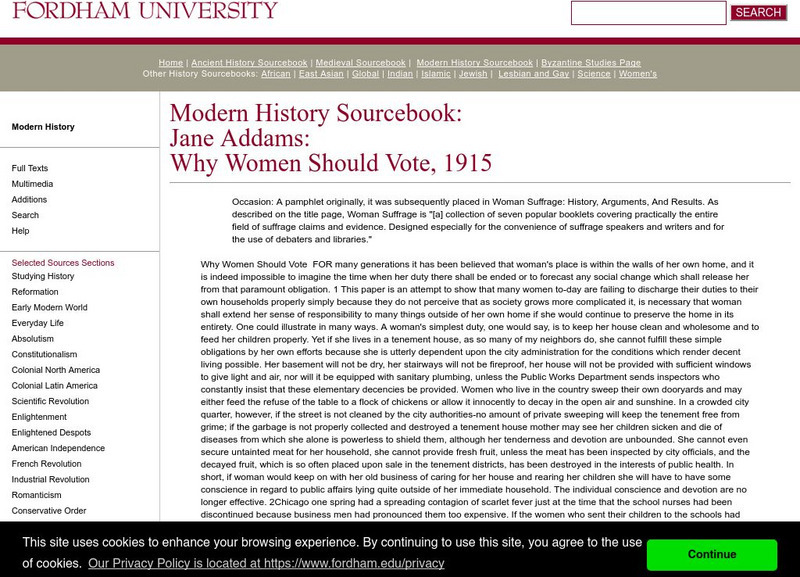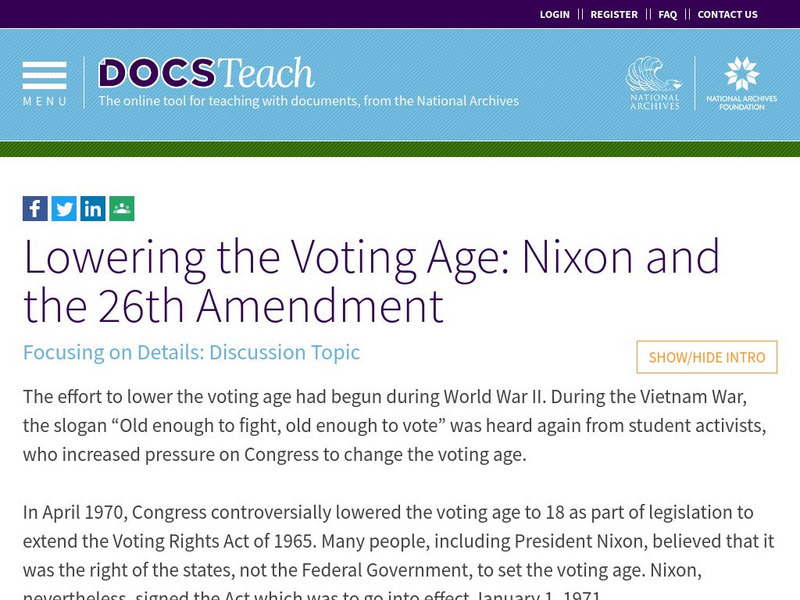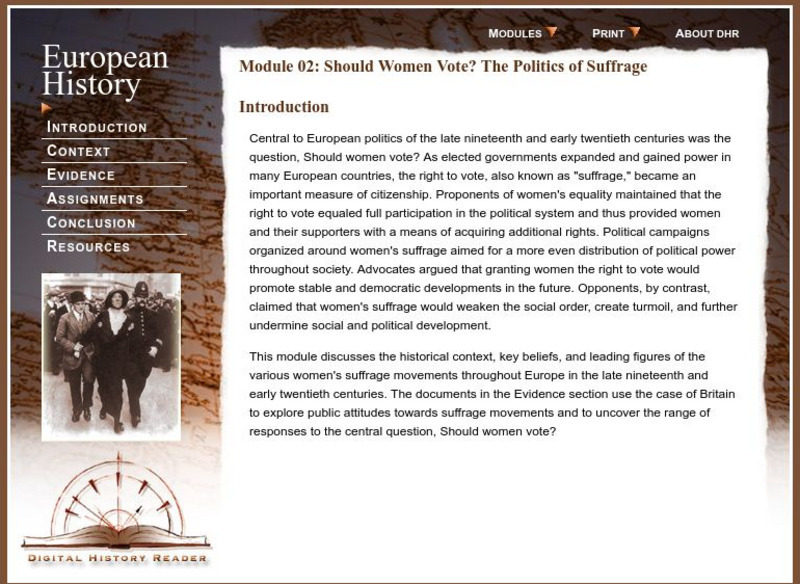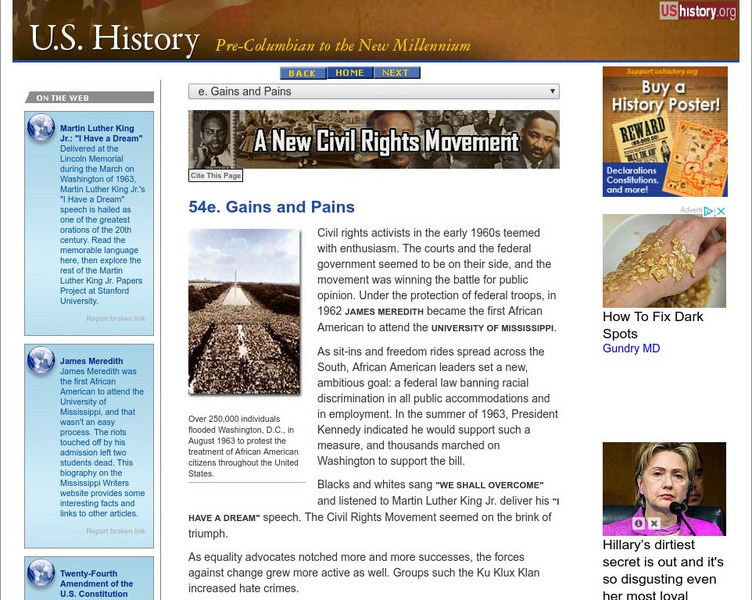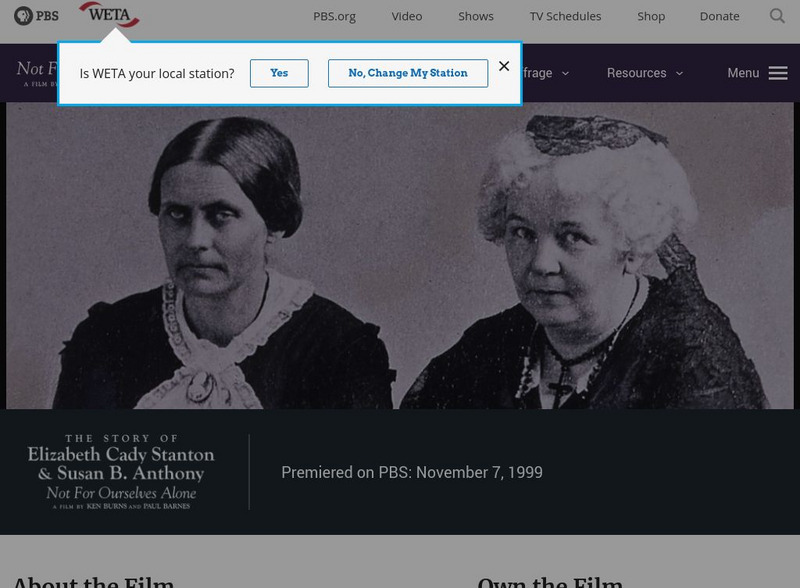National Women’s History Museum
National Women's History Museum: Seneca Falls Convention
Students will examine primary sources about the Seneca Falls Convention in 1848 to understand why a women's rights movement was necessary to gain greater rights for women.
Gilder Lehrman Institute of American History
Gilder Lehrman Institute: History Now: Securing the Right to Vote: Selma to Montgomery Story
[Free Registration/Login Required] Lesson plan asking this essential question: "What conditions created a need for a protest march from Selma to Montgomery in 1965 and what did that march achieve?"
A&E Television
History.com: Native Americans Weren't Guaranteed the Right to Vote in Every State Until 1962
Native people won citizenship in 1924, but the struggle for voting rights stretched on much longer. Native Americans couldn't be U.S. citizens when the country ratified its Constitution in 1788, and wouldn't win the right to be for 136...
Library of Congress
Loc: Teachers: Suffrage Strategies: Voices for Votes Lesson Plan
Students will learn all about the history of suffrage for women and what influences were used to change people's attitudes. They will then use their understanding to create a modern-day election document of ephemera, for example, a...
OpenStax
Open Stax: Contesting Futures: America in 1960s: Lyndon Johnson and Great Society
Read about the reforms and legislation undertaken through Lyndon B. Johnson's concept of the Great Society. These included economic and educational reforms, consumer protection, changes to immigration laws, and the Voting Rights Act of...
Internet History Sourcebooks Project
Fordham University: Modern History Sourcebook: Douglass Archives
Check out this primary source pamphlet written by Jane Addams, who pushed for a woman's right to vote during the Progressive Era.
Internet History Sourcebooks Project
Fordham University: Modern History Sourcebook: Susan B. Anthony
Read women's rights activist Susan B. Anthony's 1873 speech on women's right to vote, given the year after she was arrested for casting an illegal vote in the presidential election.
National Women’s History Museum
National Women's History Museum: Freedom Summer
During the summer of 1964, hundreds of college students flooded Mississippi to register African Americans to vote.
Other
The Center for Voting & Democracy: Gerrymandering
This site provides a brief description of the term gerrymandering and where the term originated.
PBS
Pbs: Learning Media: Why Should Women Vote? The Suffrage Question
In this activity, students view eleven different documents arguing both for and against women's right to vote. They must click and drag them in the order that they were created. As they work, they need to make a list of the arguments...
The History Cat
The History Cat: Fight for the Nineteenth: The Fight for Women's Suffrage
Looks at the history of the movement to obtain equal rights for women, starting with the Seneca Falls Convention in 1848, up to the passage of the Nineteenth Amendment in 1920, when women won the right to vote.
US National Archives
Docsteach: Lowering the Voting Age: Nixon and the 26th Amendment
This activity encourages young scholars to think critically about the history and importance of the 26th Amendment, that granted the right to vote to American citizens aged eighteen or older.
Raleigh Charter High School
Mrs. Newmark's Page: Civil Rights
This interactive activity focuses on the Civil Rights Movement.
Virginia Tech
Digital History Reader: Should Women Vote? The Politics of Suffrage
Meet the prominent people engaged in fighting for woman's right to vote throughout Europe around the turn of the century. This unit provides circumstances leading to this fight, documents supporting the right, suggested writing...
PBS
Wnet: Thirteen: Freedom: A History of Us: Working for Freedom: Susan B. Anthony [Pdf]
A lesson plan from the producers of the 16-episode PBS series "Freedom: A History of US" designed to aid understanding of Susan B. Anthony's contributions to the women's suffrage movement. Students will look at the language of the...
Other
Women's International Center: Women's History in America
This site discusses the social conditions in America that led to the Women's Movement, along with some women's world history.
Library of Congress
Loc: Teachers: Suffragists and Their Tactics Lesson Plan
Students work with two document collections, "Votes for Women: Suffrage Pictures: 1850-1920" and "Votes for Women: 1848-1921", to understand how the suffragists changed the requirements for voting in America.
University of Missouri
Exploring Constitutional Conflicts: Women's Fight for the Vote
Find out how women won the right to vote. Read a brief history of the women's suffrage movement and the text of the Nineteenth Amendment.
Library of Congress
Loc: Her Story
A rich Library of Congress resource page that is filled with links to historical and primary documents offering a female perspective throughout history. Lesson plan links are also given.
Independence Hall Association
U.s. History: Gains and Pains
Read about the legal gains made by the civil rights movement, including the Civil Rights Act of 1964, juxtaposed against the real-life actions meant to deny African Americans their right to racial equality not just legally, but...
Digital History
Digital History: The Tumultous 1960's
The decade of the 1960s was a time of protest about the Vietnam War and civil rights, and progressive legislation addressing many problems. Find primary source material, charts, and statistics that cover these topics. Included are...
Other
Women in History: Jane Addams
Click here to see a photo of Jane Addams & read her biography. Read about her dedication the Hull House, a settlement house in Chicago.The first female to win the Nobel Peace Prize, Addams was also known for her support of women's...
Wikimedia
Wikipedia: Nineteenth Amendment to the United States Constitution
Learn about the 19th Amendment to the United States Constitution. It guarantees that a person cannot be denied the right to vote based on their gender. Includes discussion of Susan B. Anthony's and Elizabeth Cady Stanton's contributions...
PBS
Pbs: Not for Ourselves Alone
This site, a companion to a PBS program, explores the lives of Elizabeth Cady Stanton and Susan B. Anthony. With ample use of video and audio commentary, the site chronicles their work, their friendship and thus the history of the...






